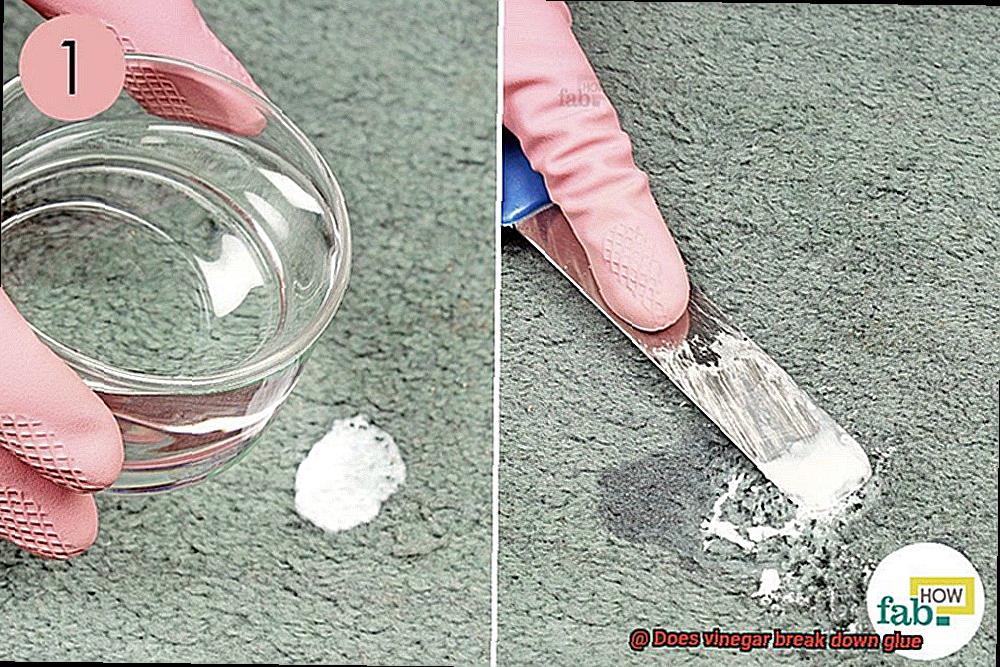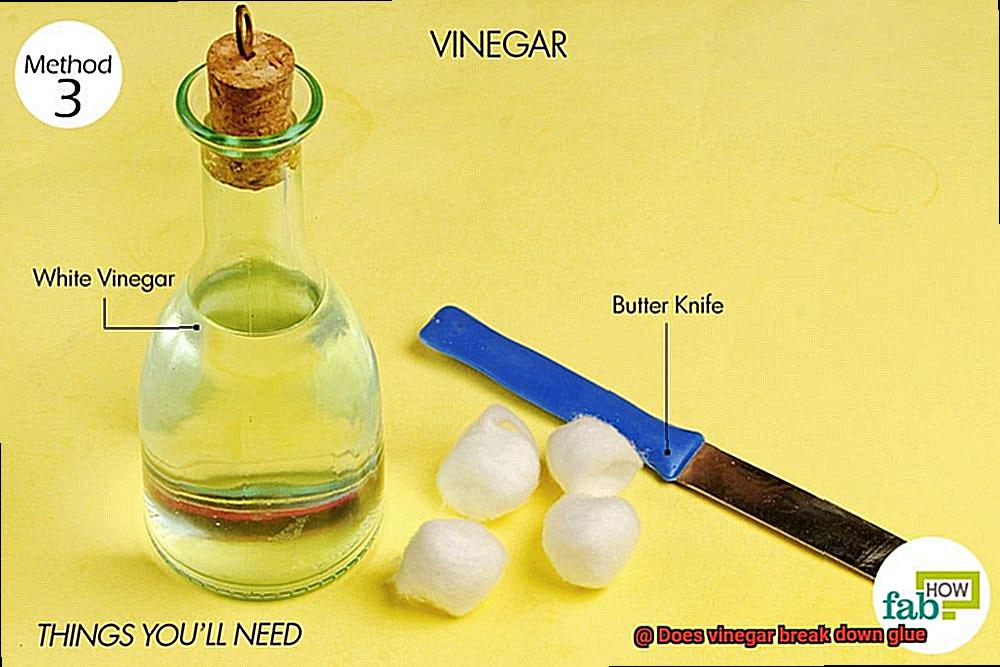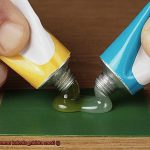Got glue sticking around where it shouldn’t? No worries, my friend. In a world full of DIY tricks and natural remedies, vinegar is the unsung hero when it comes to breaking down stubborn adhesive. This kitchen superstar isn’t just for jazzing up your salads or pickling cucumbers. Its secret powers also include loosening the grip of sticky substances like glue, making it a must-have for all your adhesive mishaps.
Now, vinegar may not have magical abilities, but its chemical makeup is no joke when it comes to tackling those pesky glue residues. In this blog post, we’ll dive deep into the nitty-gritty science behind vinegar’s reputation as the ultimate adhesive breakdown agent. So grab that trusty bottle of vinegar and get ready to bid farewell to all your glue-related headaches once and for all.
What Is Vinegar and Does It Break Down Glue?
Contents
- 1 What Is Vinegar and Does It Break Down Glue?
- 2 Types of Glue and How They React to Vinegar
- 3 Factors That Determine the Effectiveness of Vinegar on Glue
- 4 Testing Vinegar on Small Areas Before Applying to Larger Surfaces
- 5 Different Ways to Remove Glue with Vinegar
- 6 Pros and Cons of Using Vinegar to Remove Glue
- 7 Alternatives to Using Vinegar for Removing Glue
- 8 Safety Precautions When Using Vinegar for Removing Glue
- 9 Conclusion
Imagine a scenario where you’re desperately trying to remove stubborn glue residue from a surface. Fear not, for vinegar might just hold the key to your salvation. In this captivating blog post, we will delve into the world of vinegar and explore its remarkable ability to break down various types of glue. Brace yourself for an informative journey as we uncover the enchanting properties of vinegar.
Vinegar Unveiled:
Vinegar, a versatile liquid with a long history, is widely known for its culinary and cleaning applications. Produced through the fermentation process of ethanol, vinegar’s main component is acetic acid. This acid imparts vinegar with its signature tangy flavor and pungent aroma that have tantalized our senses for centuries.
Decoding Glue:
Glue, a substance used to bond surfaces together, comes in diverse forms with varying compositions. The chemical structure of each type of glue determines its susceptibility to the dissolving power of vinegar.
Vinegar vs. Glue: A Clash of Titans:
- Polyvinyl Acetate (PVA) Glue: PVA glue, often referred to as white glue, is water-based and contains polymers that form bonds upon drying. Vinegar’s acetic acid disrupts these bonds, weakening the glue and facilitating the removal or separation of glued objects.
- Cyanoacrylate Glue (Super Glue): Super glue exhibits rapid hardening upon contact with moisture, creating a formidable bond. However, vinegar acts as a solvent for super glue by dismantling its molecular structure and weakening the bond, enabling its removal.
The Limits of Vinegar’s Power:
While vinegar can effectively break down certain glues such as PVA glue and super glue, it may prove ineffective against other adhesive substances. Epoxy or silicone-based adhesives, for instance, are resistant to vinegar and necessitate alternative removal methods. Additionally, the efficacy of vinegar can vary based on factors such as its concentration and the duration of contact with the glue.
Types of Glue and How They React to Vinegar
Hey there, curious 5th graders. Are you ready to embark on a sticky adventure as we explore the world of glue and its reactions to vinegar? Get ready to uncover the secrets of different types of glue and how they fare against the mighty power of vinegar.
- PVA Glue: Imagine a craft project using white glue or wood glue – these are types of glue called PVA glue. When vinegar and PVA glue meet, it’s like a friendly handshake – not much happens. Vinegar has a weak effect on PVA glue, so it takes time for the bond to weaken. Think of it as a patient game of tug-of-war between vinegar and PVA glue.
- Super Glue: Now, let’s turn our attention to the superhero of glues – super glue, also known as cyanoacrylate glue. This glue is like a fortress with impenetrable walls because vinegar can’t easily defeat it. The strong bonds of super glue make it highly resistant to vinegar. So, when vinegar tries to break its bond, it’s like trying to break a steel wall – not easy at all. Super glue remains undefeated against vinegar.
- Epoxy Glue: Picture yourself mixing two components together to create a powerful adhesive. That’s epoxy glue for you. It’s used for building things like planes and cars. When vinegar encounters epoxy glue, it’s like a gentle tap on the shoulder – not much happens. The chemical reaction between vinegar and epoxy is minimal, so the bond stays strong like an unbreakable alliance.
- Hot Glue: Have you ever used a hot glue gun for your crafts? Hot glue is like melted plastic that hardens quickly. When vinegar meets hot glue, it’s like waving at a friend – nothing really changes. Vinegar doesn’t have a big impact on hot glue, so it remains sticky and strong. Hot glue stands its ground against the vinegar invasion.
- Rubber Cement: Rubber cement is an adhesive made from rubber polymers dissolved in a solvent. It’s commonly used for arts and crafts projects. When vinegar challenges rubber cement, it’s like playing a game of tug-of-war – the vinegar weakens the bond, making it easier to remove or dissolve. The vinegar slowly erodes the bond, giving you the upper hand.
- School Glue: Finally, let’s talk about school glue, the trusty glue we use for our school projects. When vinegar meets school glue, it’s like a little nudge – the vinegar has a moderate effect. Over time, the vinegar can weaken the bond, making it easier to remove. It’s like a persistent friend who keeps tapping on your shoulder until you give in.
Factors That Determine the Effectiveness of Vinegar on Glue
In this informative article, we will delve into the factors that determine the effectiveness of vinegar on glue, equipping you with the knowledge to conquer any sticky situation that comes your way.
Type of Glue:
Glues come in various forms, each with its own chemical composition. This composition dictates how well the glue reacts to vinegar. Natural-based glues like animal hide or plant adhesives tend to succumb easily to vinegar’s powers, while synthetic glues or those with strong chemical bonds may prove more resistant. Identifying the type of glue you’re dealing with is essential before employing vinegar as a solvent.
Concentration of Vinegar:
The concentration of vinegar plays a significant role in its effectiveness on glue. Acetic acid is the magic ingredient responsible for breaking down adhesives. Higher concentrations of acetic acid, such as those found in distilled white vinegar (5-7% acetic acid), boast superior adhesive-breaking abilities compared to lower concentrations like apple cider vinegar (4-6% acetic acid). However, it’s crucial to exercise caution with higher concentrations, as they can be corrosive and potentially damaging to certain surfaces.
Duration of Exposure:
Patience truly is a virtue when using vinegar on glue. While some glues may yield to vinegar upon contact, others require more time for the acid to seep in and weaken their bonds. To maximize effectiveness, allow the vinegar to sit on the glue for several minutes before attempting removal. For stubborn or older glue stains, multiple applications and longer exposure times may be necessary.
Temperature:
Believe it or not, temperature influences vinegar’s glue-dissolving prowess. Higher temperatures amplify vinegar’s solvent properties, making warm vinegar more effective than its cold counterpart. However, caution is warranted when experimenting with extreme temperatures. Boiling vinegar, for instance, poses safety risks and can potentially damage certain materials or surfaces.
Surface and Material Compatibility:
Before embarking on your vinegar and glue removal adventure, consider the surface or material to which the adhesive is adhered. While vinegar is generally safe for use on many surfaces, conducting a compatibility test in a small, inconspicuous area is always wise. Delicate fabrics or specific wood finishes may be more susceptible to damage from vinegar or its acetic acid content. Exercise caution and exercise judgment if unsure about the impact of vinegar on the surface.
Testing Vinegar on Small Areas Before Applying to Larger Surfaces
Are you tired of stubborn glue residue that refuses to budge? Vinegar might just be your secret weapon. But before you embark on a vinegar cleaning spree, there’s an important step you should never skip – testing it on a small area first.
Why is this small-scale test so crucial? Let’s break it down:

- Assessing Vinegar’s Effectiveness: Not all glues are created equal, and the same goes for vinegar’s ability to break them down. By testing vinegar on a small, inconspicuous area, you can see firsthand how it interacts with the specific type of glue you’re dealing with. This will help you determine if vinegar is effective in dissolving the adhesive.
- Cleaning the Area: Before conducting the test, make sure to clean the area thoroughly. Removing any dirt or debris will ensure accurate results and prevent interference with the vinegar’s performance.
- The Test: Soak a cloth or cotton ball in vinegar and gently dab it onto the glue, being careful not to saturate the area. Let the vinegar sit for a few minutes to allow it to penetrate and start breaking down the adhesive.
- Observing the Results: After a few minutes, use a clean cloth or sponge to wipe away the vinegar and any dissolved glue. Take a close look at the results – if you notice the glue softening or dissolving, it’s a good sign that vinegar is effective for that particular type of adhesive. However, if there’s no change or if the glue remains intact, vinegar may not be the right solution for that specific glue.
- Patience is Key: Keep in mind that vinegar may not work on all types of glues, especially those designed to resist moisture. Some glues may also require more time for vinegar to fully dissolve them. So, be patient and allow enough time for the vinegar to work its magic before drawing any conclusions.
By testing vinegar on small areas first, you can avoid potential mishaps or irreversible damage to larger surfaces. It’s a simple step that allows you to determine whether vinegar is the right solution for your glue-related issue. So, take the time to conduct this small-scale test and proceed with confidence, knowing that vinegar is indeed effective in breaking down the glue you’re dealing with.
Different Ways to Remove Glue with Vinegar
Glue can be a sticky situation, but don’t worry, vinegar is here to save the day. Vinegar is a versatile household ingredient that can help break down and remove glue from various surfaces. Let’s explore different ways to use vinegar for glue removal.
One simple method is to soak the affected area with vinegar and let it sit for a few minutes. The vinegar will start to break down the glue, making it easier to remove. After soaking, gently scrape off the softened glue with a plastic scraper or credit card.
For smaller items or surfaces, you can apply vinegar directly to a cloth or sponge and gently scrub the glue until it loosens. If you’re dealing with larger items or surfaces like furniture or countertops, create a vinegar solution by mixing equal parts vinegar and water. Soak a cloth in the solution and apply it to the glue, letting it sit for a few minutes before scrubbing away.
For stubborn or dried-on glue, warm the vinegar before applying it. Heat a small amount of vinegar in the microwave or on the stovetop until it’s warm but not boiling. Apply the warm vinegar directly onto the glue and let it sit for a few minutes before attempting to remove it.
If vinegar alone doesn’t do the trick, try combining it with other household ingredients. Mix equal parts vinegar and baking soda or add a few drops of dish soap to the vinegar solution before applying it to the glue. This powerful combination can help break down even the toughest glues.
Vinegar is generally safe to use on most surfaces, but it’s always best to test it in an inconspicuous area first to avoid any damage or discoloration.
Remember, while vinegar can work wonders on many types of glue, it may not be effective on all adhesives. Some strong glues, like epoxy or super glue, may require more specialized solvents for removal. Additionally, vinegar may not be suitable for delicate surfaces like wood finishes or fabrics as it can cause damage.
Pros and Cons of Using Vinegar to Remove Glue
Look no further than your kitchen pantry for a natural and effective solution – vinegar. Vinegar is not only a versatile ingredient in cooking, but it also boasts powerful adhesive removal properties. In this article, we will explore the pros and cons of using vinegar to remove glue, so you can make an informed decision for your sticky situations.
Let’s start with the advantages. Firstly, one of the biggest benefits of using vinegar is its accessibility and affordability. You probably already have a bottle of vinegar sitting in your kitchen cabinet, ready to be used as a cleaning agent. Unlike specialized adhesive removers, vinegar is readily available and won’t break the bank.
Secondly, another pro of using vinegar is its natural and non-toxic nature. If you’re concerned about the harsh chemicals found in commercial adhesive removers, vinegar is a safe alternative. It doesn’t contain any harmful substances that can harm you or the environment. Plus, it won’t leave behind any strong odors that can linger in your space.
Thirdly, vinegar is also effective at dissolving certain types of glue, such as white glue or glue stick residue. Its acidic properties break down the adhesive bonds, making it easier to remove the glue from surfaces. Additionally, vinegar has other cleaning properties and can help remove stains and grime from various surfaces, making it a versatile cleaning agent.
However, there are a few drawbacks to consider when using vinegar. Firstly, it may not be suitable for all types of glue or surfaces. Stronger adhesives like epoxy or super glue may not be easily dissolved by vinegar alone. It’s always best to test vinegar on a small, inconspicuous area before applying it to larger surfaces.
Secondly, vinegar is also not recommended for use on delicate or porous materials such as silk or unfinished wood. It can potentially cause damage or discoloration to these sensitive surfaces. Exercise caution and consider alternative methods for removing glue in these cases.
Thirdly, another potential downside is that vinegar may require more time and effort compared to specialized adhesive removers. While vinegar can break down the adhesive bonds, it may take longer for the glue to fully dissolve and be removed. Patience and persistence are key when using vinegar as an adhesive remover.
Lastly, vinegar may leave behind a lingering odor after use. Although the odor will dissipate over time, it may be bothersome for some individuals. If you’re sensitive to smells, ensure proper ventilation while using vinegar or consider using alternative methods.
Alternatives to Using Vinegar for Removing Glue
First on the list is rubbing alcohol. This potent solvent can break down the adhesive properties of glue, making it easier to remove. Simply apply a small amount onto a cloth or cotton ball, gently rub it onto the affected area, and let it sit for a few minutes. Then, use a scraping tool or your fingers to peel off the softened glue.
For tougher glues like superglue or epoxy adhesive, acetone is your secret weapon. Found in nail polish removers, acetone is a powerful solvent that can dissolve even the strongest adhesives. Apply a small amount onto a cloth or cotton ball, let it sit for a few minutes, and carefully remove the softened glue.
If you prefer a natural alternative, citrus-based cleaners can do the trick. These cleaners contain natural solvents that break down the adhesive properties of glue. Apply some onto a cloth and rub it onto the glue until it softens and can be easily removed.
Believe it or not, kitchen staples like vegetable oil or peanut butter can also help remove certain types of glue. Apply a small amount of either substance onto the glue, let it sit for a few minutes to soften the adhesive, and gently remove it with a scraping tool or your fingers.
Remember to test any solution on a small, inconspicuous area before applying it to avoid potential damage. Not all alternatives will work on every type of glue or surface.
Safety Precautions When Using Vinegar for Removing Glue
When it comes to using vinegar as a powerful adhesive remover, your safety should be a top priority. By taking a few simple precautions, you can ensure a safe and effective glue removal experience. So, let’s dive into the necessary safety measures when using vinegar for removing glue.
- Suit up with protective gloves: Before you start working with vinegar, put on a pair of protective gloves. Vinegar is acidic, and prolonged contact with your skin can lead to irritation or burns. Don’t let those stubborn glues get the best of your hands – cover them up and take charge.
- Choose your battlefield wisely: Working in a well-ventilated area is crucial when using vinegar. Its strong smell can be overpowering, especially in enclosed spaces. Prioritize your respiratory health by opening windows and letting the fresh air in. If you have a fan, turn it on to keep the air circulating and prevent those pesky fumes from building up.
- Protect those precious peepers: Accidents happen, and nobody wants vinegar in their eyes. If you’re working with a substantial amount of vinegar or using it for an extended period, consider wearing protective eyewear. Safety glasses or goggles will shield your eyes and keep them safe from any accidental splashes or spills.
- Avoid toxic cocktails: Mixing vinegar with other chemicals or cleaning agents is a big no-no. Trust me, you don’t want to create a hazardous blend of fumes or reactions that could put your health at risk. Stick to using vinegar on its own – it’s got enough power to handle that stubborn glue all by itself.
- Read, read, read: Take a moment to read the instructions provided on the vinegar bottle or any other products you’re using alongside vinegar. Manufacturers include specific safety guidelines for a reason – they know their stuff. Ignoring these instructions could lead to accidents or outcomes that are less than desirable.
- Keep vinegar out of reach: Children and pets are naturally curious, and we don’t want them getting into mischief with vinegar. While vinegar is generally safe, it’s best to store it securely in a designated area to prevent any accidental access.
jDwySevLEqw” >
Also Read: Will vinegar remove Gorilla Glue? – Glue Things
Conclusion
In conclusion, vinegar is indeed effective at breaking down glue.
Its acidic properties work to dissolve the adhesive bonds, making it easier to remove sticky residues. Whether you’re dealing with a stubborn sticker on a glass surface or trying to unstick two glued objects, vinegar can be your go-to solution.
So next time you find yourself in a sticky situation, reach for the vinegar bottle and let its powerful properties do the work for you.






